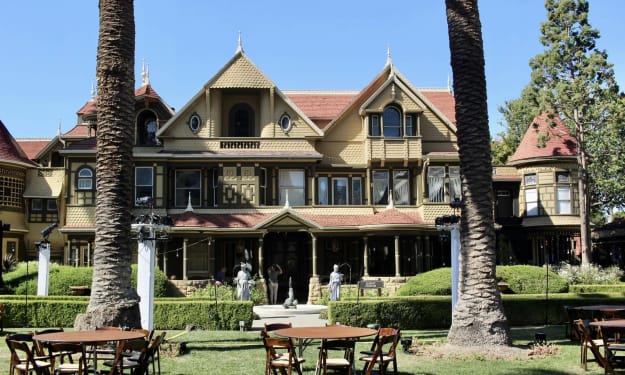
My mother once told me she had a strange, unsettling dream one night, wherein we had packed our bags for a return home to the States (from the Central American military base we were living on currently). Ridiculously, we had on heavy winter coats, although it was burning up outside. Suddenly, said my mother, a figure loomed up in the concrete stairwell going down to the ground floor. It was a terrifying figure with a fedora hat.
"It was only after I saw that movie that I realized the guy in my dream WAS THE GUY FROM THE MOVIE."
I tell this story partly because such things fascinate me, partly because I had a similar experience with the old silent sci-fi epic Metropolis (1927), long one of my favorite films. I dreamed of the "Moloch" sequence of the film before I ever actually saw the film--a fact that, to this day, I can't explain rationally. I CAN explain it insomuch that the images of our Collective Unconscious, the "Wireless Internet" of the sleeping, dreaming brain, pulls images, or gives birth to them, long before they are ever represented, logically and linearly, in what we falsely perceive and believe to be the "waking world" of reality.
And so the image, idea, the concept of the "Dream Killer,", Freddy Kreuger, existed before the film existed. In the sleeping, dreaming mind of ALL possibility.
***
My book:
Cult Films and Midnight Movies
"From High Art to Low Trash" Vol 1
By Tom Baker
But we aren't here to speak of metaphysical philosophy or the paranormal. I rewatched A Nightmare on Elm Street after several years and found that, while its shocks are still to an extent effective, it is the brutal, in-your-face subtext of Reagan Era wealth and affluence contrasted with the plight of the poverty class: the corruption and decadence at the heart of the American Dream; the hypocrisy of bourgeoise values, American Idealism, and American Imperialism (the later belies the former) contrasting sharply, creating the hideous nightmare that would swallow a generation of "Elm Street Children" in the scarred-visage, rotten-toothed maw of a predator they feared. That ugliness that represents, to the characters as well as the spectator, overwork, underpay, the steaming hot boiler room of Freddy, a nasty, low-class child predator who KILLED his tender, innocent victims, swallowing up the future to murder memories of an idyllic past--one he was never able to partake in.
But we get ahead of ourselves.
The Elm Street Children
The plot is already well-known. Nancy (Heather Langenkamp, who is perfect for her role) and her friends, Rod (Jsu Garcia), Tina (Amanda Wyss), and boyfriend Glen (a very young and handsome Johnny Depp) are all having bad dreams. Little by little it is revealed all of these nightmares star the same scarred killer, who has a glove with metal "claws". During a sleepover, Tina is brutally killed after waking from a surrealistic nightmare, one in which the killer has grotesquely elongated arms and chases her. There is a whiff of the demonic, The Exorcist, or similar tales of poltergeists; Tina is dragged UP the wall and to the ceiling while boyfriend Rod watches helplessly. She is hideously mutilated. Strangely, too, since the trope of "blood on the ceiling" is used twice here, it may be a sly suggestion of the idea behind the phrase "Twilight Zone," which, of course, inspired the title of the classic television show: i.e. the place that is neither "right side up or upside down"; in other words, the world turned topsy-turvy.
Rod is taken in for the murder, and Nancy and her boyfriend Glen continue to have bad dreams. Nancy's father, Don, (veteran cop show heavy the late John Saxon, playing, predictably, a cop), and mother, the alcoholic Marge (Ronee Bakely), are separated, the American dream, as exemplified by the beautiful suburban home on pleasant, quiet Elm Street, having fractured. But, what is revealed later proves it was, after all, rotten to the core, all along.
Saxon, representing the face of American Moral Authority (which was ceded long ago, many would argue, in the steaming jungles of Vietnam), cannot track down the killer of the jailed Rod (who was in jail for the killing of Tina), and witnesses his daughter become more and more unhinged, a sleepless wreck who steadily begins to realize the monstrous phantom killer of her nightmares is a real killer; and that if she "dies" in her dreams, she dies. (Wes Craven, the late director of this film, actually based the concept on a series of articles he read concerning the mysterious deaths of young men from the Pacific Rim, who complained of hideous nightmares, leading to sleeplessness, and frantic efforts on the part of the victims to stay awake--at any cost. One young man even had several coffee makers going at one time (!), and Nancy, in this film, has one hidden when her mother takes the first away.)
The dream sequences are powerful, beginning slowly and building to the cat-and-mouse chase through a warped horror terrain. In the final throes of the film, Nancy is seen enacting one of Craven's favorite ritualistic scenes: the boobytrapping of a private residence by the hero or protagonist. Nancy does this on no sleep, in record time, expertly; she could have given lessons to the Viet Cong. Absurd.
However, the meat here is that Freddy is not any ordinary demon., The dirty, blue-collar, low-class child killer is back "from beyond" for revenge. It seems while he was truly guilty of those crimes, Freddy was let loose by the System on a technicality. In the Grand Old Tradition of American Lynching, he was tracked back to the boiler room wherein one supposes he worked and BURNED ALIVE. Momma Thompson even took his "knife glove" as a grim souvenir.
Reagan-Era Nightmares
At the time of the making of A Nightmare, Reagan had rebuilt America along the economic trajectory of a "trickle down" that never trickled down; it vacuumed up. In true dogged Right Wing fashion, the "Sins of the Fathers" were foisted off onto convenient scapegoats: the poor, the homeless, etc. Deregulation and the push to ensure the rich got richer and everyone else got the shaft was what was fueling the "moral authority" of the Reagan Revolution. There was affluence, prosperity, and good times--for some. As Blue Velvet (1986) also demonstrated a few years later, there is a pestilence lurking beneath that All-American evergreen lawn, the dirty, insectile parasites are swarming.
Freddy, the surrealistic Dream Demon who bends pleasant, cafe au lait society until it is a sickening, murderous nightmare, is the ugly hidden Truth at the heart of the illusion of Reagan's America, or the idyllic past that is a tapestry of racial lynching and grinding economic injustice. Made flesh.
From the nightmares of yesteryear. Freddy lives, but only in the darkest recesses of the Id. And here he is not a pop cultural comedian, played for laughs. Here he is dark, demonic, and relentless. By contrast, Nancy is just a kid trying to survive; albeit, a smart and determined one.
The final denouement is that WE create the monsters of our nightmares, giving them power over us, until we determine that said power is too great, that it may overwhelm us; that we may, in fact, in our dreams die.
It is then that we either take away that power or capitulate to the darkness.
Either way, pleasant dreams.
In a final note: It is interesting to note that the character of Vulcan, also known as Merciber or Hephaestus in Greek and Roman Mythology, also worked in a forge, a kind of "boiler room," and that he, like Freddy, was said to be monstrously ugly. Both fashion metals (Hephaestus was a blacksmith, while Freddy fashioned his iconic glove), and both are intimately connected to flame; i.e. Freddy was literally "burned alive." Prometheus stole this fire to impart humanity with the spark of the "Divine"; and give them their dreams, so to speak. Freddy the Fire-Burned brings dreams he bends into nightmares. These parallels were pooh-poohed by ChatGPT, but there it is.
A Nightmare on Elm Street (1984) Official Trailer - Wes Craven, Johnny Depp Horror Movie HD
About the Creator
Tom Baker
Author of Haunted Indianapolis, Indiana Ghost Folklore, Midwest Maniacs, Midwest UFOs and Beyond, Scary Urban Legends, 50 Famous Fables and Folk Tales, and Notorious Crimes of the Upper Midwest.: http://tombakerbooks.weebly.com






Comments (1)
I still remember seeing it for the first time. A compelling redefining of the horror genre for me. It was no longer monsters you had to battle but forces beyond your control, things you couldn't necessarily see or touch, but it could you. Fascinating interpretation in the context of Reaganomics (Voodoo Economics). I've never referred to it as a vacuum. I've always described it as siphoning.